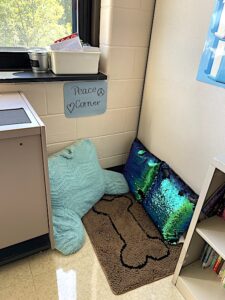New to Teaching Grades 4-6? Try These Ideas
If you know or are working with a new teacher in the intermediate grades, we hope you’ll share Kathie’s article!
By Kathleen Palmieri

Trust me, we have all been where you are now. Once you’ve taken a good deep breath, there are a few key ideas to consider as you embark on your first year.
Find a mentor
Most districts have a mentoring program that new teachers must complete during their first three to four years, depending on experience. I am part of the “Teacher Induction Team” in my district, and one of our roles is to match new teachers, known as proteges, with tenured teachers, known as mentors. Next, we plan our inservice programs to help teach district initiatives, helpful classroom management ideas, and required observation information.
The role of the mentor is to ensure that their protege has a colleague to learn from. Our topics include building-specific programs, classroom setup, planning with a team, and offering demonstrations of how to teach various subjects.
The Teacher Induction program and the mentoring are key elements to having a successful first few years in our district. If your district does not offer this type of program, find a veteran teacher to mirror and be able to go to with questions and for advice.
Take time to review the curriculum
What reading, social studies, science, and math programs does your district use? Using the teacher’s manuals, take time to look through and grasp the key elements and objectives. Ask for a curriculum map for grade level subject areas to help pace your lessons and prepare. Take advantage of any professional development offered by your district or online by the publishing companies.
For example, enVision Math offers videos that you can watch to see a lesson in action. Another is Wit & Wisdom that offers video resources that provide morphology and writing lessons. I am confident most curriculum companies offer many online resources that will be helpful.
Decide how you will record your plans
Currently, I have a teacher planner from Erin Condren that I write in to keep track of meetings, lessons, and other important items. In the past, I’ve used a Happy Planner which is a disk building planner. Both planners offer organization and structure, and personal preferences will guide your decision.
In addition, I use Google Documents to create a digital planner to keep track of lesson pacing, resources needed and links to materials. I can easily transfer this information into my Google Classroom. Why both? The physical planner allows me to map out my ideas, while the digital planner helps me to expand on my lessons and resources.
I highly recommend that you use a section of whatever planner you choose to document all of your professional development, books read, committees you are on, and ways you’ve expanded on your practice. This will come in handy at your summative review at the end of the school year.
Google Classroom
If your district provides Google Suite, take advantage of the ability to create a Google Classroom. This digital platform helps to communicate with not only students but also their guardians/parents. In addition, you can collaborate with colleagues adding them as teachers.
With Google Classroom you can set up lessons and materials for a week or more, making access to resources stored there easy to display on an Interactive White Board. Many digital resources can be housed and provided to help differentiate lessons/groups. On a weekly basis guardians/parents get an update on their child’s progress with any Google Classroom assignments. My earlier article provides more information: Prepping for My Next Google Classroom.
Google Lists
Create checklists using Google List. As you begin to tackle your first year, keep track of what you did along the way. Check off items and use this throughout the year to help keep you organized and on track. The best part of a digital product like Google Lists is that you can use it year after year, and it is easily available to you. I use mine on my Apple phone, and it is extremely useful rather than carrying a notebook. You can also take notes easily using Google Notes.
Google Sheets
A great tool for keeping track of student data. You can learn more in my article Using Google Sheets to Track Student Data. Start tracking at the beginning of the year and your conference time is a breeze.
Create an organized physical classroom
One of the key components of engagement is a planned space and organization. I have found that creating seating groups for students helps to establish collaborative learning. Designate areas such as mailboxes, bins for student textbooks/books, pencil sharpening, and class supplies. Have a bin for completed homework/work.
A key strategy I have used for years is to tie a highlighter to the work bin with a sign that instructs students to highlight their name prior to turning in their work. This helps to eliminate the nasty “no name” papers. Also, use a number system where each student alphabetically is given a number that is theirs for the year. This helps to quickly put student papers in order for ease in grading.
Be sure to have a “flow” to your intermediate classroom that allows students to transition easily from subject to subject as they get their books and supplies. You will also want to be able to rotate smoothly from group to group during lessons to check for understanding. For more on this topic, check out my article Flexible Seating Creates Vibrant Learning Spaces.
Setting up a classroom library
You may have a collection of books that you’ve purchased or been given over the last few years as you prepared to be a teacher. You do not need to start with a huge classroom library, as this will build itself over time. However, having a designated space in your room where students can go to relax with a book is always a nice idea. If you only have a few books for students to borrow, set them out.
Many teachers subscribe to Scholastic Book Clubs and this is a great way to earn free books with student orders, as well as to create a “WishList” for families to purchase for the classroom. Local libraries often hold book sales where you can purchase books for as little as $1.00 for hardcovers. Other sources are garage sales and your local GoodWill.
Finally, building a digital library is a great way to integrate technology, reading, and offer hundreds of books to your class. Check out my article Here’s How I Created a Virtual Class Library.
Decorating your classroom

There are many ways to get items for your classroom without purchasing them yourself. You can post a proposal on Donorschoose.org for what is needed in your classroom. Build an Amazon “Teacher Wish List” for items that would be helpful in your classroom. This list could include anything from student folders to a teacher presentation chair. Post your list on social media such as “X” (formerly Twitter), and use a hashtag such as #clearthelist.
Many teachers work together to repost each other’s lists, and many lists are “sprinkled” – meaning that an item or two was purchased, or cleared, or that someone purchased all items on your list.
Commit to ensuring self-care
Keep a journal reflecting upon how you do things – setting up for a lesson, thoughts and feelings about what worked/what didn’t, etc. This journal will be extremely helpful in guiding you and making decisions on your practice. Reflection is a key element in teaching, as well in the observation process.
It is extremely important to set boundaries for yourself, meaning don’t let your teaching take over your life. I highly recommend Jenny Grant Rankin’s Book First Aid for Teacher Burnout: How You Can Find Peace and Success. I reviewed this book and found it very useful and supportive. It helps to conquer those areas that make you feel overwhelmed as well as to find enjoyment in being at school and working collaboratively with colleagues.
Finally, use this link to find many other helpful MiddleWeb articles and book reviews I’ve written to enrich your teaching practice. Please feel free to reach out to me. I wish you an incredible new school year with your early middle graders!
Kathleen Palmieri is a National Board Certified Teacher and NBCT Professional Learning facilitator. She is a fifth grade educator in upstate New York who reviews and writes regularly for MiddleWeb. With a passion for literacy and learning in the classroom, she participates in writing workshops, curriculum writing endeavors, and math presentations.
As a lifelong learner, Kathie is an avid reader and researcher of educational practices and techniques. Collaborating with colleagues and globally on X (formerly Twitter) and expanding her education adventures at www.kathleenpalmieri.com are ongoing practices.






























